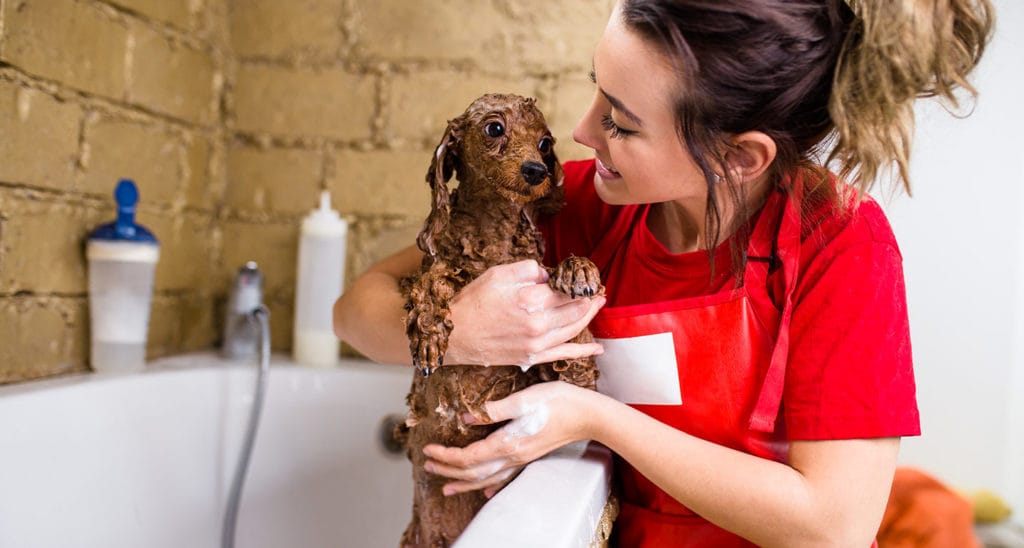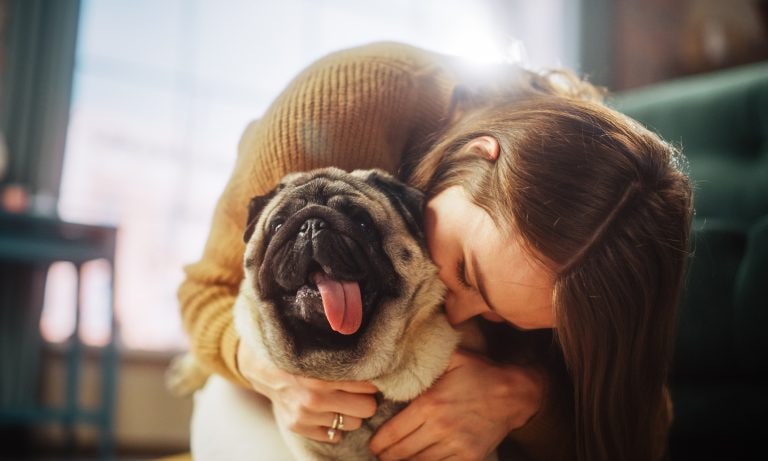Fleas are the most common external parasite found on dogs and cats. These pests can be found in most parts of the country, and even the most pampered pets sometimes find themselves with unwelcome hitchhikers.
While a flea and tick medication recommended by your vet can help keep your pet pest-free, a trip to the pet salon can be an important step in solving a flea problem.
“We are part of a team, along with the pet [parent] and their veterinarian,” says Cheryl R. Workman, ISSC-certified Master Pet Stylist and owner of The Grooming Gallery in Mooresville, Indiana.
Do Groomers Remove Fleas?
Lucky for you and your pet, groomers are often experts at finding fleas and performing “flea funerals.”
Tiny and fast moving, it’s entirely possible for your dog to have fleas that you don’t know about. During a thorough grooming, an experienced pet stylist will be able to check out every part of your dogs’ body while they wash, dry and brush your pet. If there are fleas, they will see them.
Pet parents can request a professional flea shampoo and grooming for their flea-infested pet.
“Arranging to have the pet receive a professional flea shampoo and grooming, while the house and yard are being treated for parasites, is something many pet owners choose to do ... [and] a flea bath can be a helpful part of a multi-pronged attack against fleas,” Workman says.
Be aware that some groomers do refuse to take in pets who are carrying fleas.
“If a client calls and explains that their dog has fleas, asking if I will groom them, I decline,” says Jenn Sinclair, CCMS and owner of Canadian pet salon The Artful Groomer in Upper Tantallon, Nova Scotia. “I explain that they should go to their veterinarian for treatment options and to give them advice on treating and cleaning their home. I treat it the same as anything else that a dog could come in with that can spread or be contagious. I want to eliminate the chances of other clients being affected.”
Professional Dog and Cat Flea Grooming Services
So, what exactly does a professional flea grooming service entail?
First, groomers choose a flea shampoo that will eliminate fleas while gently cleaning the pet’s skin and coat.
There are many brands and types of flea shampoo for dogs available, some have pesticides such as pyrethrin or permethrin in them, which are highly effective at killing parasites on contact. (Note: Permethrin is very toxic to cats and should never be used on them.) Veterinary Formula Clinical Care Flea & Tick Shampoo, for example, contains pyrethrins to control fleas and ticks. Other types feature natural oils to kill fleas. An example of this is TropiClean Maximum Strength Natural Flea & Tick Dog Shampoo.
Most groomers will begin by wetting and then shampooing the dog’s neck, so that any fleas that try to escape the washing process by hiding on the head are caught before they can take refuge in the pet’s eyes, ears, nostrils and lip folds. Once the neck is treated, the rest of the body is saturated with the shampoo.
Because flea shampoo can be very harsh on the dog’s eyes, groomers will use extreme care to keep it away from those delicate organs. Once the pet is fully lathered, most flea shampoos need to remain on the pet for a minimum of 10 minutes. This may vary by brand, so groomers must be familiar with the products they are using. In some cases, a groomer will use a fine-toothed flea comb, like Safari Wood Handle Flea Comb for Dogs, to remove fleas on the pet’s head while they are soaking for the required time. Captured fleas can then be rinsed down the drain.
Cat flea grooming services are similar, offering a flea bath for cats, except groomers must choose their shampoo very carefully. Cats need specialized flea products and can become ill, (sometimes fatally) if the wrong products are used. Learn more about what to look for (and avoid) in a flea shampoo for cats here.
So, does flea shampoo work? Yes, it will kill most fleas if it is used properly and left on the pet as long as the label directs. It will not repel new fleas from hopping on the pet, however. This is why it is only one step in eradicating fleas, and pet parents should consult their veterinary to put proper prevention in place.
Does Shaving Dogs Help with Fleas?
Some pet owners choose to have their dog’s hair clipped closely during the months that fleas are most commonly found. But does shaving dogs really help with fleas?
“It can help with flea detection more than prevention,” Sinclair says. “I also think that thick, double coated dogs are actually more protected from fleas as long as they are regularly groomed. Pet owners should be aware that regular skin checks and brushing are effective ways to make sure no fleas are on their pets.”
Workman points out that a dog or cat might have to be shaved due to the results of the excessive scratching caused by the pests. “Because fleas can cause intense itching, many dogs develop matting in the areas where they scratch. In some cases, the pet requires shaving to remove the matted hair,” Workman says.
While in some cases, shaving can better enable pet parents to see if fleas have taken up residence on their pet or help with the effects of an infestation, it’s not an effective flea treatment or prevention.
Share:












